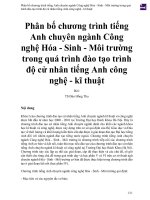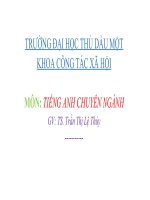bài thuyết trình tiếng anh chuyên ngành môn công tác xã hội
Bạn đang xem bản rút gọn của tài liệu. Xem và tải ngay bản đầy đủ của tài liệu tại đây (1.27 MB, 26 trang )
TRƯỜNG ĐẠI HỌC THỦ DẦU MỘT
KHOA CÔNG TÁC XÃ HỘI
MÔN: TIẾNG ANH CHUYÊN NGÀNH
GV: TS. Trần Thị Lệ Thủy
-----------
Group 3:
1. Nguyễn Trần Trâm Anh (Leader)
2. Nguyễn Thị Đào
3. Nguyễn Thị Linh
4. Nguyễn Võ Hoài Ngọc
5. Trương Thị Thanh Lam
6. Phan Hoàng Mỹ Phụng
7. Võ Hoàng Khải
8. Võ Tiến Phúc
Vocabulary
War (n)
chiến tranh
Poverty (n)
nghèo đói
Individual (n)
Cá nhân
Community (n)
Cộng đồng
Urban (adj)
(thuộc) thành phố, đô thị
Congress (n)
Quốc hội
Opportunity (n)
Cơ hội
Economic (adj)
Kinh tế
Education (n)
Giáo dục
Corps (n)
Tập đoàn, tổ chức
Vocabulary:
- Proclamation:
- Auspices:
- Scale:
- Comprehensive:
- Approximately:
- Federal:
The “War on Poverty” and the “Great Society”
In the early 1960s, well-publicized exposes of poverty and the emergence of new “structuralist”
perspective on social problems forced Americans to rediscover the over 40 million people,
approximately one third of them children, whose lives had been bypassed by modern economic and
social progress. They inspired the development of the new kinds of social service organization, such as
Mobilization for Youth in New York, and led to President Johnson’s proclamation of an “unconditional
war on poverty” in January 1964.
Trong những năm đầu thập niên 1960, các công bố công khai về
đói nghèo và sự xuất hiện mới của quan điểm “cấu trúc” vấn đề
xã hội, buộc người Mỹ phải tìm lại hơn 40 triệu người, trong đó
có khoảng 1/3 là trẻ em, những người có cuộc sống bị bỏ quên
bởi những tiến bộ kinh tế và xã hội hiện đại. Họ lấy cảm hứng từ
sự phát triển của các loại mới về tổ chức dịch vụ xã hội, như vận
động các thanh niên ở New York, dẫn đến việc công bố về một
“cuộc chiến tranh vô điều kiện về đói nghèo” của Tổng thống
Johnson vào tháng Giêng năm 1964.
The primary instrument of the “War on Poverty” was the
Economic Opportunity Act (EOA) which included such
programs as the Job Corps, Upward Bound, the Neighborhood
Youth Corps, Community Action, Head Start, Legal Services,
Foster Grandparents, and the Office of Economic Opportunity
(OEO). In 1965, Congress enacted Medicare and Medicaid,
established the Department of Housing and Urban
Development (HUD), funded an array of services for the aged
through the Older Americans Act, and created the Food Stamp
Program under the auspices of the Department of Agriculture.
Công cụ chính của cuộc chiến tranh chống đói nghèo là Đạo luật hành
động cơ hội kinh tế, trong đó bao gồm các chương trình như Nghiệp
đoàn, Giới hạn trở lên, Đoàn thanh niên khu vực, Hành động cộng đồng,
Mở đầu, Dịch vụ pháp lý, Nuôi dưỡng người già và văn phòng cơ hội
kinh tế. Năm 1965, Quốc hội đã thông qua chương trình chăm sóc người
già trên 65 tuổi và chương trình chăm sóc sức khỏe, thiết lập Bộ Nhà ở và
phát triển đô thị, tài trợ một loạt các dịch vụ cho người già qua Đạo luật
Người Mỹ cao tuổi, và tạo ra chương trình con tem bên dưới thực phẩm
dưới sự bảo trợ của Sở Nông nghiệp.
The Elementary and Secondary School Education Act
overtuned longstanding precedents and directed federal aid to
local schools in order to equalize educational opportunities
for children. In 1966, the Model Cities Act targeted certain
urban areas with comprehensive services and emphasized the
concept of community control. Although the social work
profession did not influence public policies on the scale it had
in the 1930s social workers played key roles throughout the
1960s in various anti-poverty and community action
programs and helped train individuals in new organization
like the Peace Corps and VISTA.
Ở bậc giáo dục Tiểu học và Trung học cơ sở hành động mở đầu
tiền lệ lâu đời và sự chỉ đạo viện trợ liên bang ở các trường địa
phương để cân bằng cơ hội giáo dục trẻ em. Năm 1966, luật
thành phố kiểu mẫu nhắm mục tiêu vào các khu vực đô thị nhất
định với dịch vụ toàn diện và nhấn mạnh các khái niệm về kiểm
soát cộng đồng. Mặc dù nghề công tác xã hội chuyên nghiệp
không làm ảnh hưởng đến chính sách cộng đồng nhưng trên
quy mô nó đã có từ những năm 1930, nhân viên xã hội đóng vai
trò chủ chốt trong thập niên 1960 trong nhiều mặt khác nhau
chống đói nghèo, và các chương trình hành động cộng đồng, và
giúp đỡ các cá nhân huấn luyện đào tạo vào các tổ chức mới
như Hiệp hội Hòa Bình và VISTA.
• True or False:
1. Congress funded an array of services for the aged through the Older
Americans Act, and created the Drink Stamp Program.
2. In 1966, the Model Cities Act targeted certain urban areas with
comprehensive services and emphasized the concept of area.
3. In the 1930s social work profession did not influence public policies on
the scale it had.
4. The Elementary and Frimary School Education Act overturned
longstanding precedents and directed federal aid to local school in order
to equalize educational opportunities for children.
5. The economic opportunity Act (EOA) included 8 programs
1. Congress funded an array of services for the aged through the
Older Americans Act, and created the
Stamp Program.
2. In 1966, the Model Cities Act targeted certain urban areas
with comprehensive services and emphasized the concept of
.
4. The Elementary and
School Education Act
overturned longstanding precedents and directed federal aid to
local school in order to equalize educational opportunities for
children.
Colum A
1. War
2. Poverty
3. Opportunity
4. Federal
5. Urban
6. Individual
Colum B
a. Living in the city
b. A situation or condition favorable for attainment of a
goal.
c. A single human being, as distinguished from a group.
d. A conflict carried on by force of arms, as between
nations or between parties within a nation; warfare, as by
land, sea, or air.
e. The state or condition of having little or no money,
goods, or means of support; condition of being poor.
f. Pertaining to or of the nature of a union of states under
a central government distinct from the individual
governments of the separate states.
Colum A
7. Proclamation
8. Community
9. Education
10. Congress
Colum B
g. A social group of any size whose members reside in a
specific locality, share government, and often have a
common cultural and historical heritage.
h. Pertaining to the production, distribution, and use of
income, wealth, and commodities.
i. Something that is proclaimed, a public and official
announcement.
j. A group of persons associated or acting together.
11. Corps
k. The act of coming together; an encounter; meeting.
12. Economic
m. The result produced by instruction, training, or study.
Answer:
1–d
2–e
3–b
4–f
5–a
6–c
7–i
8–g
9–m
10 – k
11 – j
12 – h
Filling the blanks
1. _________ is an enemy of humanity.
2. The young needs ___________ at school to have full
development of their capacities.
3. Success of a group is the effort of ___________ .
4. Many Syrians runs away from their country to
escape _____.
5. There will be an extra ________ on women’s right
this year.
6. ______ is more develop than rural area.









